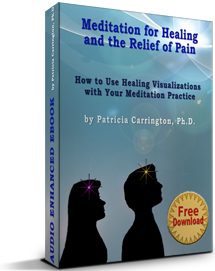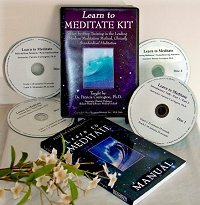Dr. Patricia Carrington's award winning meditation technique CSM (Clinically Standardized Meditation) is a clinically sensitive meditation method developed by the Medical Department of New York Telephone Company and used by numerous medical institutions, organizations, and individuals worldwide. For information click here.
Meditating Under Special Circumstances
Meditating When Ill
Patricia Carrington, Ph.D.
Author of “”
Meditating as often as one wishes when ill can be very useful for certain persons. A friend of mine to whom I had taught CSM about a year previously had to have abdominal surgery. When she was lying in the hospital immediately following this surgery and under heavy medication for pain, she remembered being instructed that when ill, she could meditate as often as possible. Actually, she had not been meditating regularly before she went into hospital, but suddenly felt strongly that she wanted to do so, and proceeded to meditate about five or six times a day during her hospital stay.
The meditation had a ‘startling’ effect on her. A pain-killer was unnecessary after her first few post-operative hours and she required no sleeping medication while in hospital. Her doctor reported that her progress was so rapid that he wanted to know what special magic she had used to accomplish this. She told him that she had been meditating, and although initially skeptical, he finally commented that he was so impressed by the way she had responded to the surgery and particularly by her lack of need for sedative drugs that ‘Whatever you’re doing, it must be right.’
But what about the advice given to TMers that says when sick they should only add extra meditations when they are so ill they cannot get out of bed? No doubt this advice serves the purpose of preventing over-meditation, but the distinction between being bedridden or not is to me an arbitrary one. The belief that extra meditations are indicated in one case and not in the other is certainly not supported by scientific research. I know of several instances where patients who were ill but not confined to bed added meditations to their day to cope with their illness and said that the results were excellent. A colleague tells me, for example, that extra meditation sessions helped him recover from a recent severe virus much more quickly than usual, although he never went to bed during the entire time.
Despite such glowing reports, people’s impressions that meditation has helped them cope better with an illness are not scientific proof that meditation actually does help recovery. For this, a controlled study would have to be carried out with one group of persons having a known illness being referred for meditation training and another group of persons with the same illness not being trained to meditate. Records could then be kept as to which group recovered more rapidly. The only carefully controlled research in these areas to date has studied hypertensive and asthmatic patients. This will be discussed later, when we come to consider the relationship of meditation to stress related illness.
A discussion of the strategic use of meditation when ill is not complete without making note of the fact that not everybody is able to meditate when ill. Certainly not all people can meditate during all types of illness. I have had several people report that when they had flu they were so weak that even though bedridden, they could not summon up the energy to meditate. If they tried to meditate it did not take, no matter how long they stayed with it. Eventually they had to abandon these attempts until they felt better. Interestingly, Yoga scriptures advise against meditating when one has fever, quite possibly a reflection of long experience with some of these difficulties.
The inability of some people to meditate when weak or feverish highlights the fact that although meditation is considered a relaxation technique, a person must possess a certain minimum amount of available energy to meditate. I have at times felt that I was, at a particular moment, too exhausted to meditate. I was so tired that the kind of alert–relaxed involvement that meditation requires was not possible. Rather than being comforting, it would become unpleasant and a strain at such a time.
As in so many other things concerning meditation, this is a highly individual matter. Some people report that meditation acts as a stimulant at times when they feel exhausted. I suspect that some of us may tend to use meditation as a calming agent while others may use it more as an energizer. This is not to say that we have a choice over the way we use meditation, but rather that our systems may have different requirements and thus make different use of this highly versatile techniq

